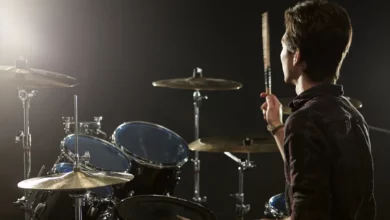
We may earn a commission from the affiliate links on this site. Learn more›
Ghost strokes or ghost notes. The coolest name for any technique on any instrument ever invented.
This time of year was made for spooky stories – I watched one play out on Netflix just last night – so it seems fitting that we’re covering ghost strokes today.
Legend has it that ghost strokes are regular strokes that died and now roam the earth looking for drum kits to haunt.
But this is not true!
Despite their creepy name, ghost strokes are among the funkiest, grooviest techniques in all of Drum Land.
Read on, and you’ll see what I mean.
Why Use Ghost Strokes?
Take a look at the three grooves below:



They’re all pretty cool, I think. They’re all reasonably lively, intricate, and interesting. If you were going to criticize them, though, you’d maybe say they’re a little bit full-on.
There are a lot of notes flying around in there. These types of loud, ‘busy’ grooves work well when you’re playing metal—or perhaps playing a track with a slow tempo.
Nevertheless, if you’re playing these grooves fast, they can quickly start to feel cluttered in most genres. This is especially true if we’re dealing with a busy arrangement that contains a bass guitar, guitar, keys, vocals, and so on. This is where ghost strokes can be essential.
What Is a Ghost Note?
It’s only fair to warn you: this is going to be an anti-climax. Despite their cool name, ghost strokes are not at all mysterious—sorry!
Simply put, a ghost stroke is just a very, very soft stroke.
The truth may be a little plain, but – like many things in drumming – it’s a bit more complicated than that in reality.
This is because listeners tend to ‘feel’ a ghost stroke rather than hear it. A ghost stroke will sit at the back of the mix and barely be perceptible to the ear, but it’ll make a big difference to the overall feel of a track.
Take a listen to Can’t Stop by Red Hot Chilli Peppers below.
You’ll hear the track has a powerful rhythmic impetus from the bass, guitar, and vocal. There’s not much emphasis on melody here. There are no soaring, dramatic vocals. It all feels pretty close to tribal, and in this case, that’s a great thing!
When you listen closely to the drum groove, you’ll hear loud hi-hat, kick drum, and snare drum notes. If you listen even more closely, you’ll also hear some faint snare hits which sit underneath everything else. These are your ghost strokes.
They’re there, and they’re not there—all at the same time. Imagine if all of the snare hits on this track were loud. You’d have a song that’s rammed full of notes, all competing for space. Playing this way could quickly become overwhelming to the listener.
Like being hit gently and repeatedly over the head with a small rubber mallet, it could quickly become irritating at best and painful at worst!
By making some of the snare notes into ghost strokes, we retain the energy of snare independence, but we allow other instruments to take the spotlight.
Ghost strokes create the perfect combination of energy and space. Every technique has its place.
Ghost strokes may not help you if you need to create a massive moment in a big rock track, but generally speaking, it’s good to utilize them when needed.
How Do I Play a Ghost Stroke?
Now we’ve talked a bit about ghost strokes, how the heck do we play them? Well—again—the answer is simple in principle but a little trickier in practice. At least at first.
Remember: when drumming, dynamic variation tends to come from the height of the stick, rather than the velocity of the stroke.
We shouldn’t try to play ghost strokes by hitting the snare gently. We shouldn’t be thinking about velocity at all.
Instead, we need to focus on keeping the stick very low and very close to the head. By keeping the stick low, we’ll make the stroke more gentle anyway.
This technique is the easiest way to make the stroke extra quiet, especially when we’re trying to do this in the context of a fast-paced groove.
Let’s try it now. If you’re able to, sit at your kit or your practice pad, and we’ll dive in.
A few simple steps:
- Start by taking the stick in your stronger hand.
- Play a normal stroke from a normal height. A few inches above the snare, perhaps. Try to let the stick bounce back up again if you’re able to.
- Lower your hand so that your hand and the stick sit a few millimeters above the drum head.
- Play the stroke from that height: be careful not to lift the stick before playing the stroke. The stick should only travel downwards. At this point, recall step two: remember how the stick bounces back up again after playing a normal stroke? In the next step, we’re going to try and control that bounce.
- Play a normal stroke from a normal height again. This time, try to catch the stick before it bounces back up. You need to catch the stick just a couple of millimeters from the head, if possible.
- Play the second stroke from the much lower height.
- When you’ve tried these steps with your stronger hand, try them with your weaker hand too.
Reflecting on the Process
I wonder how you found that? You’ll have no doubt noticed that a stroke played closer to the head sounds way quieter than a stroke played from further away.
This is precisely how ghost strokes work. Try practicing steps five and six in particular:
- Drop the stick from height, catch it low, and play the low stroke.
- Repeat this several times.
- Alternate between both hands.
Ghost Strokes in a Groove
Let’s return to the three grooves that we saw back at the beginning of the article. You’ll see them re-printed below, except that now we have some brackets around the snare notes.
In standard drum kit notation, a bracketed snare drum always represents a ghost stroke. Remembering the seven steps above, try to play these grooves with the ghost strokes in place. Keep that snare hand low when you come to a ghost stroke.



If this is new to you, it’s normal to find a ghost stroke challenging at first. Take things slowly. Don’t become frustrated and don’t rush.
Remember: starting slow often feels like ‘the long way around.’ But in most cases, it’s a short cut. If you practice something fast fifty times over, you might get it right once.
If you practice something ten times, but at a really slow pace, you’ll start to get it right much more quickly.
Above everything else, focus on those stick heights!
Don’t let your snare hand sneak up on the ghost strokes. Keep it low. As you play through the grooves with the ghost strokes in place, you may notice that the primary snare hits occur on beats two and four.
The grooves are still pretty complicated, but they feel far less cluttered now. This is one of the significant advantages of using ghost strokes.
It’s important to say that—like all ghosts—this technique gets better with age. Just as the scariest ghosts in horror films tend to come from the deep, dark shadows of history; playing a great ghost stroke will take time and practice.
This means that it’s probably counter-productive to expect perfection straight away. If your ghost strokes are even just a little quieter than your standard strokes at the moment, you’re already onto a winner.
Over the coming weeks and months, you’ll notice your snare hand developing more and more control. You’ll see it becomes more comfortable and more natural to catch the stick nice and low.
In short, you’ll notice your ghost strokes becoming more and more ghost-like as time goes on.
A Few More Thoughts
At the start of this foray into ghost strokes, we talked about how useful they can be in ensuring that a groove—or a song—doesn’t become too cluttered.
This is true, but there’s a more in-depth idea that we can reflect on as well. Think of an outrageously beautiful landscape or skyline that you’ve seen in the past.
Sure, some incredible natural sights – and some exciting cities – look pretty flat. But many don’t.
Many natural landscapes are beautiful because of their mountainous terrain, dramatic cliffs, or rolling hills. New York’s skyline is world famous because of its dramatic highs and lows as one building gives way to the next.
Famous paintings usually contain light and shade, as well as changes in texture and color. Whether we’re thinking about high art or a three minute YouTube video: variety creates interest.
Our drum grooves are already pretty varied by their very nature: they contain deep kick drums, cutting hi-hats, and mid-range snare notes.
Nevertheless, we can add even more interest by varying the dynamic levels within our groove. By using ghost strokes, we create light and shade with our playing. The contrast between each loud and soft stroke enriches the feel and makes sense of texture, which may otherwise be lacking.
In the very same way that an artist uses shading to change a picture from two dimensions into three, we can create an extra dimension in our grooves with ghost strokes.
This may not always be essential in every song—sometimes, we need to hammer out something flat and raw, as Dave Grohl does in Smells Like Teen Spirit by Nirvana.
Generally speaking, though, the use of ghost strokes can only help to add a sense of depth into our grooves.
A Bonus Exercise
One of the hardest things about playing ghost strokes is managing to control the stick’s height at the right time.
Practicing this next exercise will help us gain control over our sticks to vary the heights more freely and more accurately.
Try this slow and first, and gradually build the speed when you’re ready to.
Developing Ghost Strokes

Wrapping Up
According to the famous maxim, variety is the spice of life. We could say this about music too. Great songs tend to feature dynamic changes, textural changes, fundamental changes, and—sometimes—tempo changes.
As drummers, we ought to consider how we can add more variety to our grooves. We also ought to consider how we can serve each song with the right balance of energy and space.
Ghost strokes are an excellent way to add variety to a groove. They’re also a perfect way to add energy to a song without cluttering up the arrangement.
They’re not necessarily easy to play at first—it takes a pretty high level of control to make sure that the stick heights are correct from one note to the next—but this is another excellent reason to practice them!
Doing so won’t just give you a new technique to use.
As your stick control improves, the rest of your playing will improve too. It’ll become more expressive and more fluid as you smoothly carve dynamic variation into
playing regularly.
Take everything slowly at first. Be patient, and over time your ghost strokes will start to haunt many of your grooves with minimal effort, making them feel groovier, more exciting, and less chaotic. Have fun, keep drumming and see you in the next article!

About the Author
Chris Witherall is a pro drummer, producer and songwriter from London, England. He loves talking about music, and helping people to reach their music goals.



